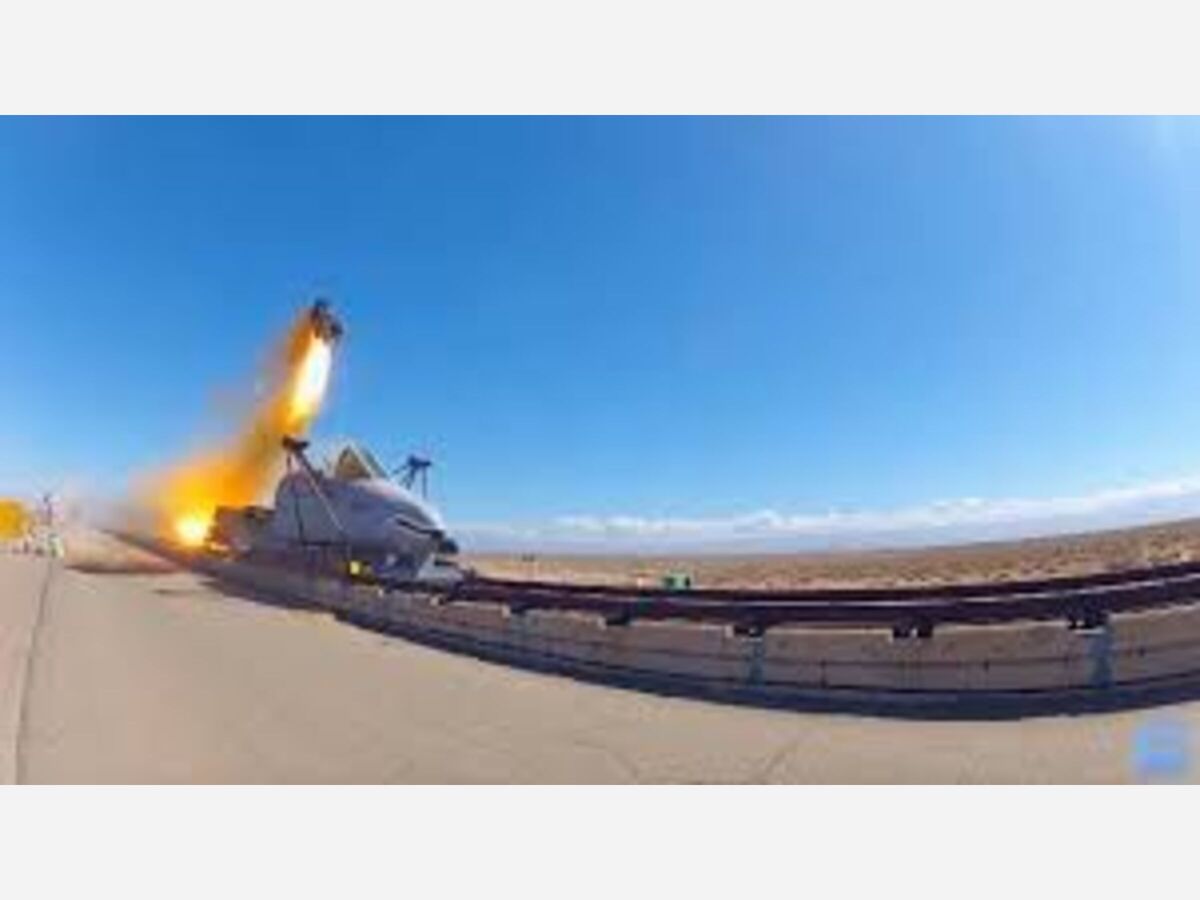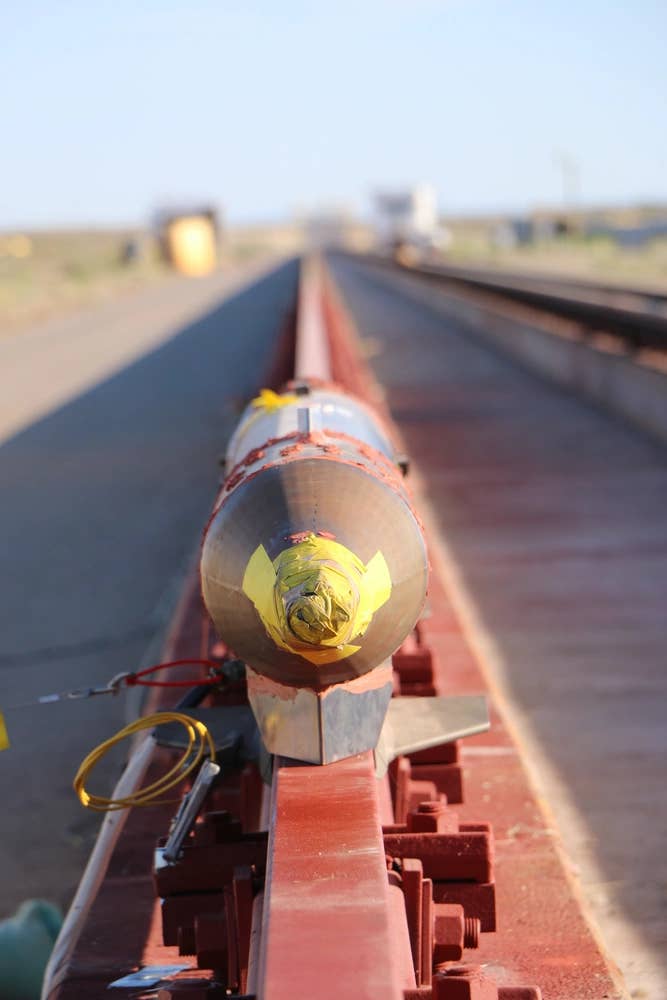Image


The U.S. Air Force’s 846th Test Squadron at Holloman Air Force Base, New Mexico, successfully recovered a reusable rocket sled after traveling at a recorded speed of 6,400 feet per second, or just about Mach 5.8 — beyond the hypersonic threshold — the Air Force reports.
This is the first time the squadron has successfully recovered a reusable rocket sled after traveling at that speed. The test was performed on the base’s 10-mile-long Holloman High-Speed Test Track(HHSTT) in late March, 2022.
While significantly higher speeds have been recorded at the HHSTT during rocket sled testing – see our previous post with footage of a rocket sled traveling at around Mach 8.6 – the rocket sled test of March 2022 represents the highest speed a reusable rocket sled has reached before being successfully recovered.
 The reusable rocket sled traveled at 6,400-feet per second on a monorail, and was recovered as part of the Hypersonic Sled Recovery effort at the Arnold Engineering Development Complex Holloman High-Speed Test Track at Holloman Air Force Base, New Mexico. U.S. Air Force
The reusable rocket sled traveled at 6,400-feet per second on a monorail, and was recovered as part of the Hypersonic Sled Recovery effort at the Arnold Engineering Development Complex Holloman High-Speed Test Track at Holloman Air Force Base, New Mexico. U.S. Air ForceThe HHSTT is the only track capable of recovering sleds that hit hypersonic velocity (meaning speeds of Mach 5 and above) via high-speed braking. Speed testing of various military components has been performed by the 846th Test Squadron on the HHSTT since the 1950s, while the track itself – which dates to 1949 – has been significantly adapted and extended since that time.
More recently, Air Force engineers implemented a Hypersonic Readiness program (HSR) in 2020, which focused principally on fielding a hypersonic 9-inch monorail sled test with high-speed braking capability. The majority of the tests performed with sleds on the HHSTT to date have focused on “non-recovered impact testing,” according to HHSTT project manager Daniel Lopez. Prior to the summer of 2021, when two sleds traveling at hypersonic velocity were successfully recovered at the track, nearly two decades had passed since recovered hypersonic missions had been conducted there.
At present, the HHSTT is 50,971 feet, or around 10 miles, long. As the Air Force indicated in late 2021, "currently, recovered high-speed – those of Mach 3 or more – and rain erosion tests are limited to one of the 10-mile-long rails in a monorail configuration." Engineers continue to update and improve testing capabilities, including the addition of newly designed birdchaser sleds for the HHSTT in late 2021 to mitigate bird and animal strikes during testing.
 A rocket sled is shown just before launch on the Holloman High-Speed Test Track at Holloman Air Force Base, New Mexico. The 9-inch monorail sled was launched as part of the Hypersonic Readiness program, April 23, 2020. U.S. Air Force
A rocket sled is shown just before launch on the Holloman High-Speed Test Track at Holloman Air Force Base, New Mexico. The 9-inch monorail sled was launched as part of the Hypersonic Readiness program, April 23, 2020. U.S. Air ForceBeing able to recover reusable sleds traveling at hypersonic velocity is important for the squadron’s Hypersonic Sled Recovery (or HSR) effort. It allows for the collection of critical data after testing is completed, which is particularly important for hypersonic weapons testing. As Lee Powell, HHSTT Capability Development Lead highlighted back in 2020, the Department of Defense relies on “HHSTT enhancements and test capacity” to deliver its modernization roadmap of nuclear forces, missile defense, and hypersonic weapons. “These programs,” he said, “require timely and relevant test data to verify lethality effects, impact survivability, aerothermal and weather effects, separation dynamics, guidance system performance, sensor performance and other key performance metrics.”
Hypersonic weapons testing, which is one of the U.S. military’s key priorities, places extreme stress on test subjects in order to ascertain which materials can withstand the heat and strain of sustained flight at speeds of Mach 5 and above. As Powell highlights in the quote above, hypersonic weapons testing is designed to reveal the limits of a weapon’s flight performance and survivability before more expensive and complicated flight testing begins. This is also true for testing materials and other components that could be used on such a weapon or vehicle.
 Another view of the reusable rocket sled tested in late March, 2022. U.S. Air Force
Another view of the reusable rocket sled tested in late March, 2022. U.S. Air ForceLt. Col. Paul Dolce, Commander of the 846th Test Squadron, stressed the historical significance of the achievement when congratulating the squadron. "What you accomplished marked the fastest recovery of a monorail sled in over 30 years, and the first time we have recovered a planned reusable sled at those speeds ever.”
“Truly historic in my books! This could not have been done without everyone here who works at the track,” Dolce exclaimed.
“These efforts will now set up our future HyTIP [Hypersonic Test and Evaluation Investment Portfolio] runs for success and add a new capability for our hypersonic customers."
Daniel Lopez echoed Dolce’s sentiments. “Excellent job to the entire team for their hard work and innovation. This just sets the bar that much higher.”
The recent success of the 846th Test Squadron validates its efforts to respond to demands for hypersonic velocity testing over the past few years. As further testing of hypersonic weapons is conducted on the HHSTT, it’s likely that recovered hypersonic missions will record even higher speeds.
History:
The Holloman High Speed Test Track (HHSTT) is a United States Department of Defense/Air Forceaerospace ground test facility located at Holloman Air Force Base in south-central New Mexico. It is adjacent to the White Sands Missile Range and is operated by the 846th Test Squadron of the 704th Test Group of the Arnold Engineering Development Complex at Arnold Air Force Base.
The Test Track provides its services to a wide variety of American defense and governmental agencies such as the Air Force, Army, Navy, and the Missile Defense Agency, as well as America's allies.
The test track is undergoing upgrades and expansion to carry its programs forward to beyond 2070. Its history dates to being constructed in five distinct sections between 1949 and 2002. The first section was around 3,400 feet long, and the first sled tests were performed on this portion of the track in 1950. The last section of the track added in 2002 brought the total length of the HHSTT to 50,971 feet and extended the narrow gauge to approximately 4 miles.
Tests performed to assess the impacts of speed on the human body were performed at the HHSTT in its early years.
On Dec. 10, 1954, Lt. Col. John Stapp climbed into a metal chair affixed to the top of a rocket-propelled sled preparing for launch at the HHSTT. After Stapp was secured, the sled was fired down the test track. The open-cockpit vehicle eclipsed speeds of 630 miles per hour. During the ride, Stapp endured around 40 times the pull of the earth’s gravity. He suffered several injuries, including broken ribs and a temporarily detached retina. But Stapp survived and, in the process, demonstrated the incredible forces the human body is capable of withstanding, thereby providing a greater understanding of human tolerance to high-speed aircraft ejections.
This ride broke the land speed record, and Stapp was thereafter referred to as the “Fastest Man on Earth.”
Stapp’s work also aided in the development of safety belts capable of tolerating a greater amount of force.
In October 1982, the HHSTT became known as the “fastest place on earth” when an unmanned rocket sled delivering a 25-lb. payload to a target reached 6,119 miles per hour. This record would stand for a little more than two decades.
The world land speed record was again set at the HHSTT in April 2003 when a rocket sled delivering a 192-lb. payload to a target reached speeds of 9,465 feet per second. This comes out to just shy of 6,500 miles per hour or around 8.5 times the speed of sound.
Ejection testing, weather erosion testing, weapons dispense testing, impact testing and aerodynamic testing are among the variety of activities performed at the HHSTT over its first 70 years.
The test track at Holloman is vital for National Security and vital to the continued growth of Alamogordo as a center of military technology, commerce and support and relevance as a support city for its personnel.
Collaborative Report by Oliver Parken associate editor of the drive.com & The Warzone & AlamogordoTownNews.com